Quadrants in Star Trek: A Guide to the Different Regions of the Galaxy
- by Kingsley Felix
- October 31, 2023

Are you a fan of Star Trek ? If so, you may be familiar with the concept of quadrants in the show’s universe.
In Star Trek, the galaxy is divided into four main quadrants: Alpha, Beta, Gamma, and Delta.
Each quadrant contains different planets, species, and civilizations that the show’s characters explore and interact with.
This article will delve deeper into the concept of quadrants in Star Trek, exploring what they are, how they work, and why they matter in the context of the show.
In the Star Trek universe, the quadrants serve as a way to divide and organize the vast expanse of space.
Each quadrant contains a variety of star systems, planets, and other celestial bodies, as well as different species and civilizations.
The quadrants are named after the first four letters of the Greek alphabet, with Alpha being the closest to Earth and Delta being the farthest.
As the show’s characters travel through space, they often encounter new planets and species in different quadrants, leading to new adventures and challenges.
Understanding the concept of quadrants is essential to understanding the world of Star Trek.
By dividing the galaxy into four distinct regions, the show’s creators were able to create a vast and complex universe that is full of exciting possibilities.
Whether you are a die-hard fan or a casual viewer, learning more about the quadrants in Star Trek is sure to deepen your appreciation for this beloved sci-fi franchise.

Overview of Quadrants in Star Trek
In the Star Trek universe, the Milky Way galaxy is divided into four quadrants: Alpha, Beta, Gamma, and Delta.
These quadrants are defined by one meridian passing through the galactic core and a second one perpendicular to the first, which also passes through the galactic core.
Most of the action in Star Trek takes place in the Alpha and Beta quadrants, which are home to many significant planets like Earth, Vulcan, and Qo’noS.
The Gamma and Delta quadrants are less explored and are home to many alien species that are not commonly encountered in the Alpha and Beta quadrants.
The galactic coordinate system is used to map out the quadrants and other regions of space in the Star Trek universe.
Star Trek star charts and maps are available for fans to explore and learn more about the various quadrants and other regions of space.
Cartography plays an important role in the Star Trek universe, as it enables the characters to navigate through space and explore new worlds.
The Starfleet Corps of Engineers is responsible for creating and maintaining the maps and charts used by Starfleet vessels.
In summary, the quadrants in Star Trek are an important part of the Star Trek universe, and understanding them is essential for fans of the franchise.
The Alpha and Beta quadrants are the most explored and are home to many significant planets.
In contrast, the Gamma and Delta quadrants are less explored and are home to many alien species not commonly encountered in the Alpha and Beta quadrants.
Quadrants in Star Trek
The alpha quadrant.
The Alpha Quadrant is one of the four quadrants in the Milky Way Galaxy, as depicted in the Star Trek series.
It is home to many important planets, including Earth, Vulcan, and Bajor.
The United Federation of Planets is also located in this quadrant, making it a significant region in the Star Trek universe.
The USS Enterprise, under the command of Captain Kirk, frequently explored the Alpha Quadrant during its five-year mission.
The Enterprise NX-01, the first warp-five starship, also traveled extensively through this quadrant during the events of Star Trek: Enterprise.
Deep Space Nine, a space station located near the Bajoran wormhole, was a focal point of the Alpha Quadrant during the events of Star Trek: Deep Space Nine.
It served as a hub for trade, diplomacy, and conflict between the Federation, the Klingon Empire, and the Romulan Star Empire.
The Alpha Quadrant also features several important starbases, including Starbase 1 and Starbase 11.
These facilities provide support for Federation vessels and serve as strategic locations for defending against threats from the Klingons, the Romulans, and other hostile forces.
The Beta Quadrant
The Beta Quadrant is one of the four quadrants and is adjacent to the Alpha and Delta Quadrants.
It is home to various races, including the Vulcans and Klingons.
The Beta Quadrant has been featured in various Star Trek series and movies , including the original series, The Next Generation, Deep Space Nine, Enterprise, and Star Trek VI.
The USS Enterprise, Enterprise NX-01, and Deep Space Nine space station have all explored the Beta Quadrant.
Captain Kirk and his crew visited several planets in the Beta Quadrant, including Angel I, Talos IV, and Murasaki 312.
In The Next Generation, the Enterprise visited Vulcan and Andoria, both located in the Beta Quadrant.
The Beta Quadrant has been the setting for many important events in the Star Trek universe.
For example, the Romulan Star Empire is located in the Beta Quadrant, and the Dominion War between the Federation and the Dominion took place in the Alpha and Beta Quadrants.
The Gamma Quadrant
In the Star Trek universe, the Milky Way Galaxy is divided into four quadrants, and the Gamma Quadrant is one of them.
It is located adjacent to the Alpha Quadrant and the Delta Quadrant.
The Gamma Quadrant is home to various planets and civilizations, including the Dominion and the Breen Confederacy.
One of the most notable features of the Gamma Quadrant is the Bajoran Wormhole, which connects the Bajoran system in the Alpha Quadrant to the Idran system in the Gamma Quadrant.
This wormhole was discovered by the crew of Deep Space Nine, a space station located near the wormhole’s Alpha end.
The Dominion, a powerful empire that controls much of the Gamma Quadrant, is a major antagonist in the Star Trek universe.
The Dominion Space is vast, and it includes many different species that the Dominion has subjugated.
The Dominion War, which took place during the later seasons of Deep Space Nine, was fought between the Dominion and the Alpha Quadrant powers.
The Breen Confederacy is another major power in the Gamma Quadrant.
The Breen are known for their advanced technology and their mysterious appearance. They are also a key player in the Dominion War.
The Delta Quadrant
The Delta Quadrant is one of the four quadrants in the Milky Way Galaxy, adjacent to the Beta and Gamma Quadrants.
It is approximately 30,000 lightyears away from the United Federation of Planets.
The quadrant was prominently featured in the television series Star Trek: Voyager, as the USS Voyager was stranded there for seven years before returning to Earth.
The Delta Quadrant is home to many different species, including the Vidiians, Kazon, and Borg.
The Vidiians are a species that suffers from a disease called the Phage, which has ravaged their society and led them to resort to organ theft to survive.
The Kazon are a warrior race that is known for their conflicts with other species in the quadrant.
The Borg Collective, a powerful and dangerous cybernetic species, also has a significant presence in the Delta Quadrant.
In addition to the various species, the Delta Quadrant is home to many unique phenomena, such as the Caretaker’s Array, which was responsible for bringing Voyager to the quadrant.
The Borg also has a transwarp hub in the Delta Quadrant, allowing them to travel quickly throughout the galaxy.
Overall, the Delta Quadrant is a fascinating and dangerous region of space, full of unique species and phenomena that make it a popular destination for explorers and adventurers alike.
Kingsley Felix
Kingsley Ibietela Felix is a digital media publishing entrepreneur and founder of Krafty Sprouts Media, LLC. A 2-time African blogger of the year. Kingsley can be found researching, reading, watching football, playing games, discussing politics or creating great content.
Leave a Reply Cancel reply
Your email address will not be published. Required fields are marked *
Save my name, email, and website in this browser for the next time I comment.
Notify me of follow-up comments by email.
Notify me of new posts by email.
You May Also Like

How to Install Last Kingdom Kodi Build?
- by Editoral Team
- May 13, 2022

What Does Atmos Mean in Movies?
- October 14, 2023

10 Most Powerful Dragons in Movies and TV Shows
- by Eti-ima Udofia
- November 10, 2023

What Does PG Mean in Movies?
- July 21, 2023

Can You Watch Netflix on Nintendo Switch?
- October 28, 2023

15 Documentaries About Education on Netflix
- by Edidiong Abraham
- September 13, 2023
Discover more from The Bingeful
Subscribe now to keep reading and get access to the full archive.
Type your email…
Continue reading
Brilliant Maps
Making Sense Of The World, One Map At A Time
Star Trek Map Of The Alpha & Beta Quadrants
The map above is Shakaar’s Alpha/Beta map v3.3; a fan-made creation showing the Alpha and Beta quadrants of the Star Trek universe.
The map shows both major and minor powers that have appeared in the various series over the years.
At the centre is the United Federation of Planets, which borders the major power of the Klingon Empire, Roman Star Empire and the Cardassian Union. More minor powers include the Breen, Ferengi Alliance, Tholian Assembly, Sheliak Corporate and the Gorn Hegemony among many, many others.
The map highlights:
- Principal Systems
- Minor Systems
- Non-Aligned Systems
- Dead Systems
- Government Borders
- Points of Interest
- Navigation Hazards
- Star Clusters
- Stations or Starbases
For more Star Trek maps see:
- Star Trek Stellar Cartography: The Starfleet Reference Library
- Star Trek Star Charts: The Complete Atlas of Star Trek
- Star Trek Maps
Enjoy this map? Please help us by sharing it:
Get Our Latest Brilliant Maps Weekly:
Other popular maps.
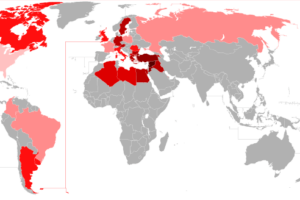
Syrian Refugees Per Capita: Who’s Been The Most & Least Generous
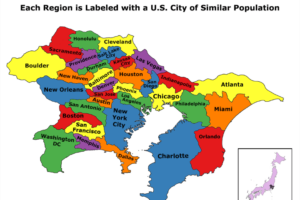
Population of the Metro Tokyo Area Compared To US Cities

World Toilet Paper Map Showing Spending On Tissue & Hygiene
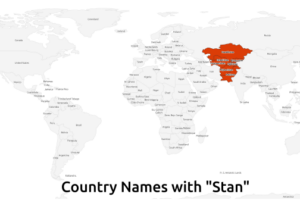
Why The United States Is A ‘-Stan’ Country Like Kyrgyzstan
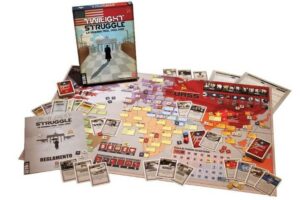
The 28 Best Map Based Strategy Board Games You’ve Probably Never Played

Scratch Map Giveaway: Win 1 of 3 Scratch Off World Maps From Landmass
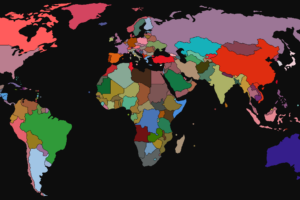
Average Colour Hue of Country & US State Flags
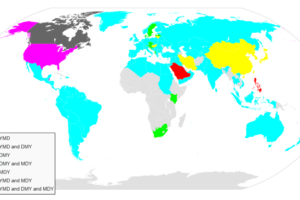
How To Write The Date In Different Countries
December 13, 2017 at 8:14 pm
I know that: a) it’s a bit of fun b) it’s hard to make a 2d map of 3d space and c) there no official maps to go off
But Christ, there’s a lot of stuff on here which makes no sense.
Justin Spaulding says
September 7, 2019 at 2:36 am
Isn’t gamma haromi 2 supposed to be in the haromi cluster…. Good effort though! S3. E8 I think. The “gatherers”
Danny Beans says
November 11, 2019 at 11:18 pm
Why are Ceti Alpha V and Ceti Alpha VI in completely different sectors? I mean, okay, Chekov can be a little dumb sometimes, but that’s one helluva mistake to make.
Jadziah Dax says
April 7, 2021 at 6:03 pm
Can’t wait to see the one you do!
petewinsemiusyahoocom says
November 23, 2022 at 3:47 pm
I agree, several planets said to be in the alpha quadrant are in the beta quadrant and vice versa or not listed at all.
Resolute_Phoenix says
February 8, 2018 at 11:41 pm
Okay so Xindus by Vulcan…. kys I’m not even gona bother looking further don’t make a map if you don’t know what your talking about
February 18, 2019 at 9:03 pm
Romulons should have Dyson sphere (at least at Romulus and Remus). Their ship tech is based on creating black holes which will give a ship a reactor core with a life of a handful of years BUT it’s just like an inefficient battery because it takes way more energy to initially create it then it will give off over its life BUT it’s portable. Sure beats light sails if your depending on home system energy and way more flexible too. This was their tech wheelhouse, and was their interstellar travel energy source instead of antimatter. It makes total sense for them to have harnessed the majority of their native suns energy to create reactor cores wherever they needed a portable energy that couldn’t tap into the system wide grid.
February 22, 2019 at 9:26 pm
A few questions… 1) Why are there several Indus VIII on the map?, 2) I do not see the First Federation on this map — they should be near the Ferengi!, 3) Where is the Kelvin planet? (The planet colonized by the Kelvins from “By Any Other Name”), 4) Maybe I’m wrong, but I do not see the Dyson Sphere that TNG crew ran into?
Shane Montgomery says
March 4, 2020 at 10:25 pm
I don’t see Barzan II or the Barzan Wormhole here?
Pickard says
January 23, 2021 at 3:39 pm
They are there. Literally the only Dyson sphere symbol near the bottom.
August 6, 2019 at 5:03 pm
Spock: He is intelligent, but not experienced. His pattern indicates two dimensional thinking.
Glenn Bryson says
November 15, 2019 at 6:52 pm
Not your fault, I know;
Vulcan is “Supposed” to be “A little over sixteen” light years from earth. Yet the map has it at around 1000. That’s one of my biggest gripes about Star Trek (I absolutely love Star Trek, don’t get me wrong). Distances and travel times are so inconsistent and unrealistic based on the documented scales, maps, etc.
March 14, 2020 at 11:46 pm
Did you mean Starbase 375 instead of 395? As in the starbase from S6 of DS9 after the Dominion took over the station?
Avro Arrow says
March 24, 2020 at 7:04 pm
I love this map, especially how you have the Hydran Kingdom, the Lyran Star Empire and the Kzinti Hegemony are listed (where is the Interstellar Concordium?). I have one small nit-pick to make and that is you have two systems named “Nelvana III”. They’re both in the upspin Beta quadrant but one is in the Romulan Neutral Zone and the other is further upspin and outward (left). I think that you might consider making most of the empty space that is coreward of Klingon and Romulan space into the ISC. They were referred to as being a Galactic Superpower residing on the far side of both those Empires (so, coreward).
Gray.Elton says
May 19, 2020 at 3:21 am
If we do or don’t do it, someone will laugh
July 15, 2020 at 1:53 am
I dont understand how this can be called a map of the star trek galaxy when there isnt even a spot or indication of where earth is. Who makes a map without earth when you have a series where its location is based on earth. In the series they refer to Earth as Earth. Yet the closes thing to it is on the map is Volcan. Y not add Earth as well? If there is an alternative name how come it’s never mentioned in the shows and a secret for fans?
Brandon says
August 15, 2020 at 4:14 pm
Earth is 100 percent there. It’s Sol. It’s a common alternate name for our star system and has been used in Trek.
February 8, 2021 at 3:26 pm
Sol system. The Greek word for sun. Follow the bold line and look for the team Terran and Vulcan sectors. Sol is on the 4 corners there
May 23, 2021 at 11:35 pm
Cheron is not in the Romulan sphere of influence. It is located in the “Southern most part of the Galaxy”, Captain Kirk. Episode “Let That Be Your Last Battlefield”
That dude says
September 6, 2021 at 5:31 am
Issues: Tykens rift, not Titans. Starbase 47 is about 10 sectors off as memory Beta says it is located between the Tholian assembly and the Klingon empire. Prophets Landing is in the gamma quadrant.
That’s all for now!
That Guy says
May 17, 2022 at 11:20 pm
Alpha Onias III is on here multiple times
John S says
November 16, 2022 at 4:31 am
Don’t the Klingon and Cardassian Empires border each other? A lot of DS9 s4 doesn’t make sense if they don’t…
martijn says
March 18, 2023 at 11:16 pm
where is earth ?
Leave a Reply Cancel reply
Your email address will not be published. Required fields are marked *
This site uses Akismet to reduce spam. Learn how your comment data is processed .
- Movies & TV
- Big on the Internet
- About Us & Contact
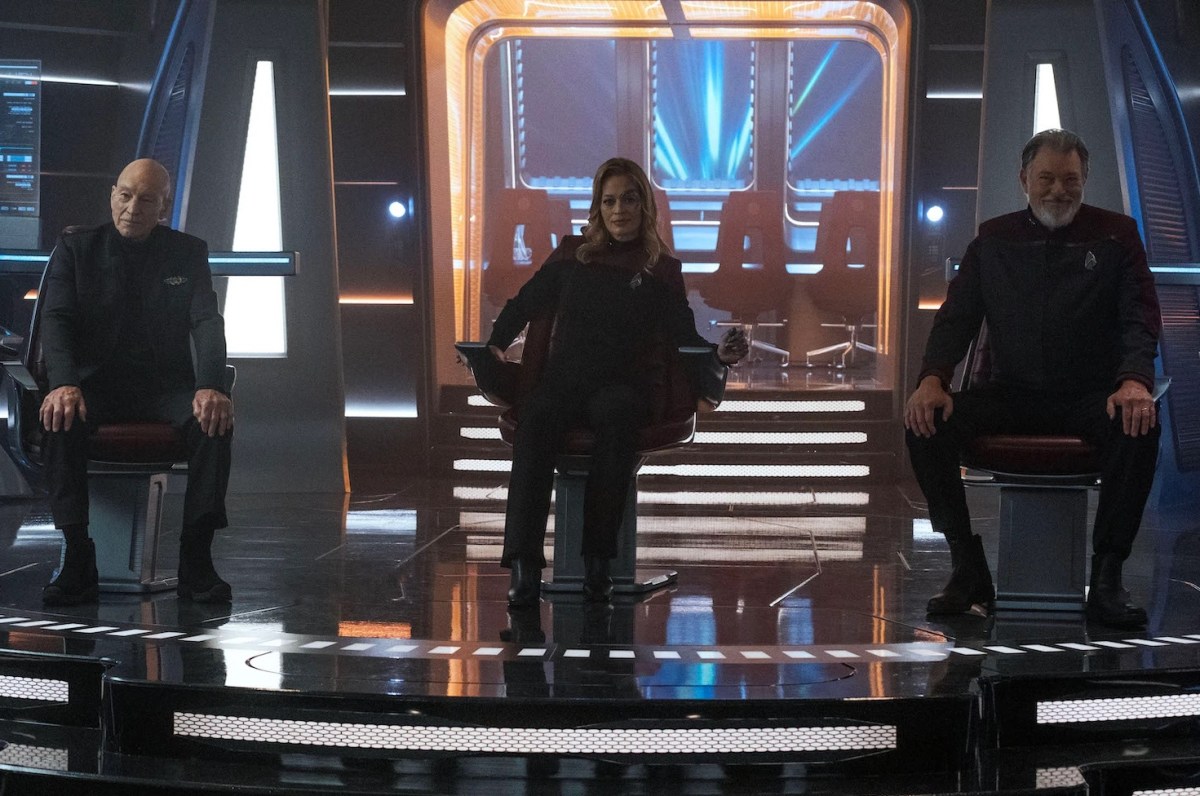
A Wannabe Blue Shirt Officer’s Guide to the Map of the Galaxy in ‘Star Trek’
No matter the fictional universe— be it fantasy or sci-fi or somewhere in between (looking at you, space operas)—I’ve always found maps and cartography one of the most fascinating parts of worldbuilding. There’s something about actually seeing how an author imagines the setting of their story that immediately grounds it in the realm of possibility, and helps immerse viewers in the worlds in which these stories unfold.
Sure, it’s somehow easier when the map consists of a single continent, kingdom, or city on Earth or any other Earth-like location. Bringing the action up into space definitely makes everything a tad more complicated—and a whole lot more fascinating.
And now that the third season of Star Trek: Picard is in full swing , there’s no better time to refresh our collective memory on the “astrogeography” the crews of the USS Enterprise explore.
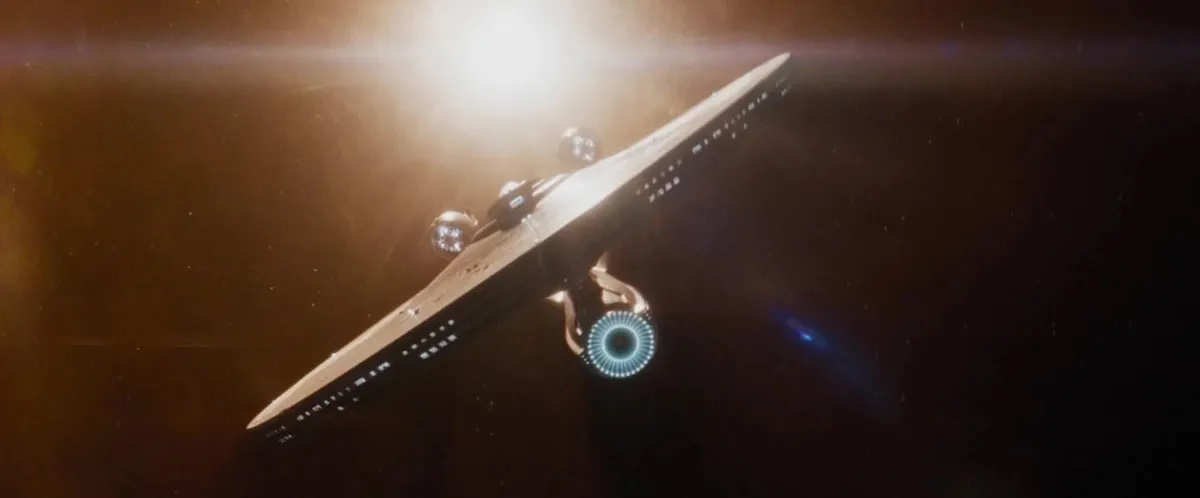
Star Trek and maps
The decades that have passed since Star Trek first premiered on television screens have made it possible for the saga to acquire beautifully complex and detailed lore on pretty much everything related to it—including the planets that make up the United Federation of Planets, and the powers that border it, like the infamous Klingon Empire.
There have actually been several maps made for Star Trek and its locations over the years, as it reads on The Map Room blog . “While original series canon assigned aliens to known nearby stars, and the shows occasionally used real locations, episode writers did not start with a map and generally did not take spatial relationships into consideration, which no doubt has made the belated mapping process a bit more challenging,” The Map Room blog continues, explaining how creating a comprehensive map of the Star Trek galaxy might be easier said than done.
Still, while none of the maps ever put to print or screen have ever been accepted as official canon, most of them have the major power players of the galaxy in more or less the same location. This means we can reasonably assume that this is the actual position in which they can be found in-universe.
The galaxy quadrants
Most of the action in the Star Trek canon takes place within our galaxy, the Milky Way, which has been divided into its famous four primary quadrants, each named after a letter in the Greek alphabet: Alpha, Beta, Gamma, and Delta.
The Alpha and Beta quadrants are the ones that are better known, even in-universe, and that house many of the major players we see throughout the various series—the United Federation of Planets chiefest of all. The Federation has a strong foothold in both quadrants, spanning Alpha and Beta from their shared border outwards.
According to Memory Alpha , the official Star Trek fan wiki, the Alpha quadrant contains two all-important planets that we all know very well: Earth, from which a good majority of the characters in Star Trek canon hail; and Vulcan, the homeworld of the Vulcans and especially of Spock. This quadrant also contains the Cardassian Union, the Ferengi Alliance, and the Breen Confederacy—among other smaller factions—whose representatives make an appearance in the canon, particularly in Star Trek: Deep Space Nine .
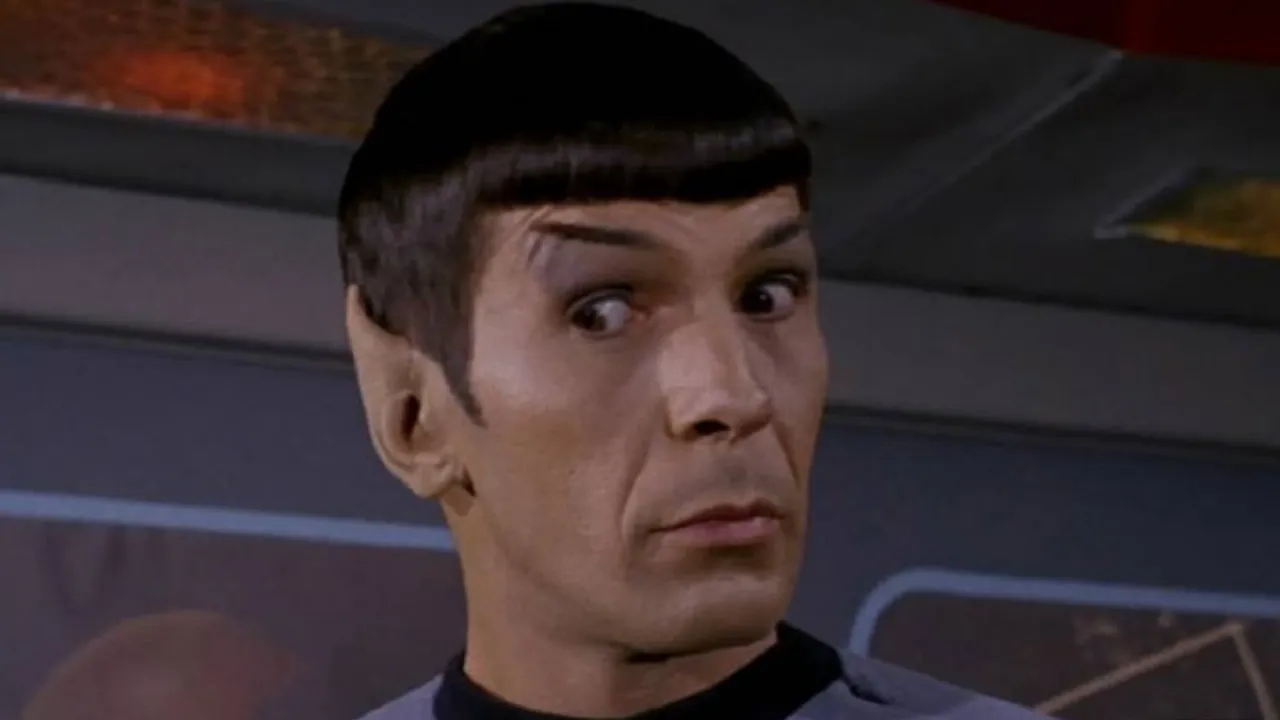
The Beta quadrant includes a couple of relatively smaller players like the Nyberrite Alliance and the Tholian Assembly, and then the major forces of the Romulan Star Empire and the infamous Klingon Empire—who both have their respective homeworlds, Romulus and Qo’noS, in this quadrant.
In contrast to the Alpha and Beta quadrants, the Gamma and Delta quadrants are considerably less well-known and less visited—which makes sense, considering the notable distances that separate them from the other areas of the galaxy, which would require years to bridge even at warp speed. Their reputation also isn’t as stellar as the areas in Federation space.
Still, they are of course mentioned time and again in the canon, as are the planets and people located within them. The Delta quadrant, for example, is the place of origin of the infamous Borg Collective, made up of the terrible Borg cyborgs.
(featured image: Paramount+)

2.1.1 The subdivision of the Galaxy
While in our time, we haven't ventured deep enough into space to need other systems for the exact determination of positions within our incredibly large galaxy than the equatorial and galactic coordinate systems, in the world of Star Trek, in which the interstellar navigation is the basis of trade, politics and the everyday life of billions of people, a further subdivision of space is used, beside the much two large division into "galaxies" and the much two small division into "planetary systems" - the subdivision into quadrants and sectors. These two terms, whose meaning was quite contradictious at the beginning, but has been exactly fixed in the meantime, have become a basic element of the space navigation shown in Star Trek through the years, since with the sector and quadrant system, a certain place can be quite precisely localized, without using a complicated coordinate system.
1. The four quadrants
Already in the era of Classic Trek, the expression "quadrant" was used for the exact determination of positions in the Star Trek universe. However, this cartographic term which literally refers to "a quarter" was used for completely different three-dimensional volumes at that time: sometimes a quadrant indeed corresponded to a quarter of the galaxy, but all too often it also denoted considerably smaller regions. In this connotation, the size of a quadrant rather corresponded to the size of a sector, like the designation "quadrant 904" in [TOS] The Squire of Gothos indicates. Up to the beginning of The Next Generation and also in the first movies the "quadrant" wasn't defined unambiguously and was used contradictorily. Finally in Star Trek VI, the current - and correct - quadrant system was introduced, according to which "the galaxy is subdivided into 4 quadrants, from which each forms a 90 degrees piece of cake, viewing the galaxy from the top or the bottom" (Star Trek Encyclopedia). An insider information on this movie even implies that the system was mainly introduced to justify Captain Sulu's claim that "he is in the Beta quadrant and currently the only Star Fleet ship in the quadrant."
Even a subspace transmission (warp 9.9999 with amplification) covers this distance in more than three months. Consequently, only the fact that Earth, the Federation and most of the other empires are located at the frontier between Alpha and Beta quadrant makes it possible that we hear something about other quadrants at all, and it isn't surprising that the two remaining quadrants - Gamma and Delta - were not explored until the era of DS9 and Voyager started, and then only with "tricks" like wormholes and intergalactic displacement waves.
2. The sectors
In contrast to the quadrants, space sectors, that are mentioned in nearly every episode (remember sector 001 - the solar system), are an astronomically small division of the galaxy and therefore more useful for the exact determination of positions in Star Fleet's everyday life - what explains their often use (although, however, in the recent seasons of Voyager and DS9 the Alpha Quadrant was mentioned in every second episode). Because the dimensions of a sector are, in contrast to the quadrants, not important for the episodes and this subdivision was always used for space regions of small scale, it isn't astonishing that the official definition was not determined "first hand" in a episode or movie (not even as background information), but in an official documentation.
At any rate, a sector is apparently not a natural, but a artificial, systematic subdivision of the galaxy into smaller space regions, what is also supported by the Encyclopedia, which suggests that "a typical sector in Federation space contains 6-10 planetary systems, although there are many more in the sectors near the Galactic core." Therefore, Sector 001 should not only contain the solar system, but also e.g. the Wolf and Alpha Centauri systems.
Just as the quadrants, also the sectors have some irregularities in their designation, but that's acceptable in this case, because of the sector numbering system of the Federation, we only know the starting point (sector 001), but not the direction of the numbering, and the situation of the numbered sectors introduced in different episodes towards each other is unknown. However, it is very likely that in view of the centuries of space exploration and already different designation systems today, the system of the Federation is contradictious itself and the sectors are numbered more or less arbitrarily. It is also possible that the sector numbers, like the registry numbers, were assigned to newly discovered space regions at entirely different locations in space with increasing sequence, and the sector system accordingly has a chronological order.
The Star Trek Encyclopedia suggests that "some sectors kept their old designations from earlier cartographing systems the same way as we use today both the older Messier and the newer NGC numbering system." In fact, some sectors apparently haven't a number at all (like the Igo Sector and the Bajoran Sector); they were named after the dominating planetary system or most important star in the sector.
2.1.2 The political division of the Galaxy
Already the mere space explored by humanity - about 5000 ly on both sides of the Alpha/Beta Quadrant border, at which Earth is located, there are six closely adjoined interstellar alliances and empires - Federation, Romulan Star Empire, Klingon Empire, Cardassian Union, Breen Confederacy, the Tholian Assembly and a dozen other important powers such as the Ferengi, Trill, Talarians, Tzenkethi and Gorn. However, actually solely the United Federation of Planets with 150+ member planets, numerous Federation protectorates and hundreds of colonized planets, which are scattered over 8000 ly and distributed to several agglomeration areas ("cores"), is large enough to be visible on an overview map without exaggerated dimensions. Beside the Federation, the sole super power in the (known) lower part of the Milky Way, however, there are more comparably large or even larger powers in the upper half: the Dominion in the Gamma Quadrant, which takes up a whole part of the Sagittarius arm of the Milky Way, and the Borg Collective, which core region has a perhaps five times as large volume than the Federation has, but whose sphere of influence extends over the half Delta and Beta Quadrant. There are still other powers in the Galaxy, but which do not owe their large territories to their political status (like the Federation as a loose, not necessarily spatially joined interplanetary alliance) or their superiority to other species in numbers or technology (like the Borg or the Dominion), but to other factors, which effect the extension of their empires. For example, the Krenim belong(ed) to the dominating super powers in the Delta Quadrant with almost a thousand planetary systems solely due to alterations of the time line, which enlarged their empire and finally made it smaller again. On the other hand, the Hirogen dominate a larger area of space despite their slow ships because of the nomadic way of life which is typical for them - they restlessly travel around to hunt their prey. The Turei inhabit a larger part of the lower Delta Quadrant, because they have access to the sophisticated subspace corridor system of the Vaadwaur. In the end, most peoples have too little influence on other empires or a too less established territory to be called a super power, so that the number of interstellar important alliances is very limited. Finally, the exact political subdivision of the Galaxy remains unknown, because our knowledge is sketchy at best. Only some small parts of the Alpha, Beta and Delta quadrants are known, in which nonetheless the territories of more than a dozen powers are located. The Gamma Quadrant could be explored merely four years, until the Dominion - the sole power known in this quadrant - prevented this. Consequently, there is enough space in the Milky Way for hundreds of interstellar alliances and empires, which could be discovered already with the next deep space mission - the Cytherians, which apparently populate a huge part of the galactic center, are only one example.
After this summarizing introduction in the general subdivision of the Milky Way and the political situation in the Galaxy, now the time has come to immerse in the Star Trek Galaxy and to examine the most important planetary alliances and empires, their location, structure, formation and development more elaborately, starting with the United Federation of Planets.
� 1999-2001 by Star Trek Dimension / Webmaster . Last update: April 27th, 2000
- More to Explore
- Series & Movies
Published May 4, 2023
What is a Galaxy Exactly?
The European Space Agency helps us understand the basics of our universe.
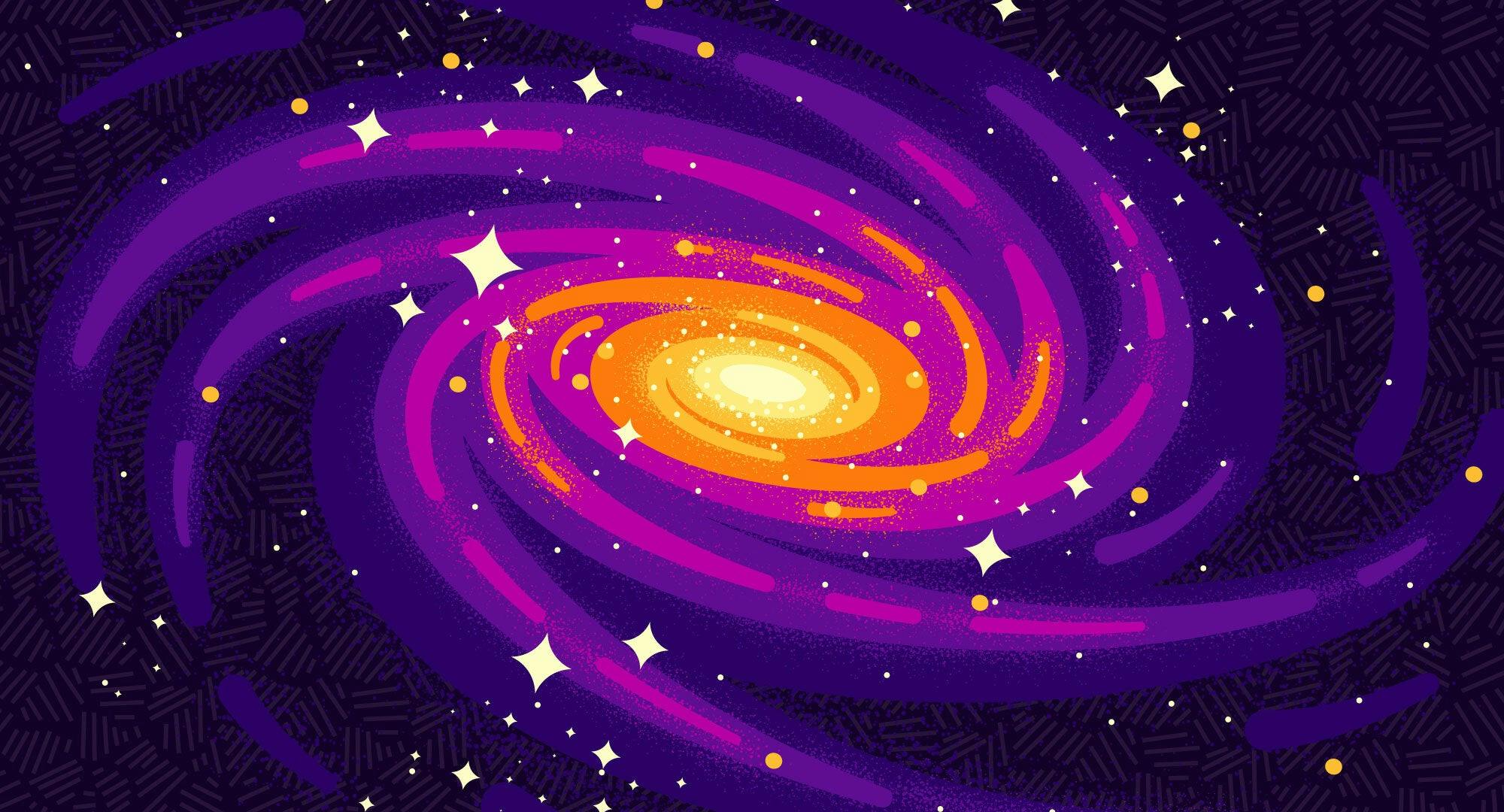
StarTrek.com

" Hear this, Picard, and reflect: 'All the galaxy is a stage .'" — Q, "Hide and Q"
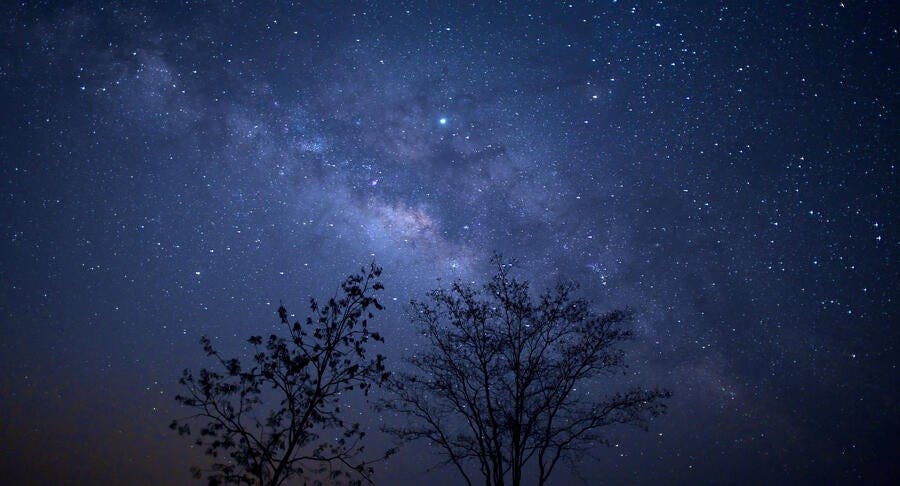
With one look up at the clear night sky from a dark spot (as in, not from a city), humans can see the overwhelming amount of stars visible to the naked eye. In some areas, the number of stars is so large that all you see is a fuzzy “milky” band across the sky. This band is the galaxy we live in — The Milky Way.
A galaxy is simply a mass of stars, gas, and dust, all held together by gravity, the same force that keeps people on the ground instead of floating away. Our galaxy is so large that light takes 100,000 years to cross from one side to the other. That leaves a lot of stars and planets still to be discovered for Star Trek in our galaxy alone!
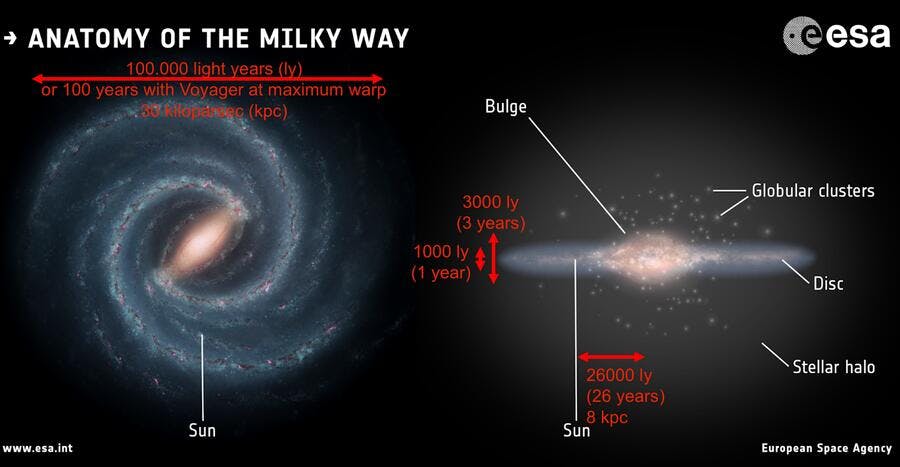
Anatomy of the Milky Way. The Milky Way in top (left) and side (right) view. Illustrated are the different components and the approximate position of our Sun in the galaxy. Adapted from ESA, to indicate the size in light years (and Voyager maximum warp travel time).
But the universe holds plenty of other galaxies aside from the Milky Way. Most of the nearby galaxies astronomers have observed can easily be classified into four groups: spiral galaxies, elliptical galaxies, irregular galaxies, and merging galaxies.
Spiral galaxies like the Milky Way, and our neighboring galaxy Andromeda, show clear disks and spiral arms and still actively form stars. Elliptical galaxies, on the other hand, are like smooth, squished spheres with very little structure or on-going star formation. Irregular galaxies like the two Magellanic Clouds are — you guessed it — irregularly shaped. And merging galaxies are simply some of the former three who are in the process of merging into one galaxy.
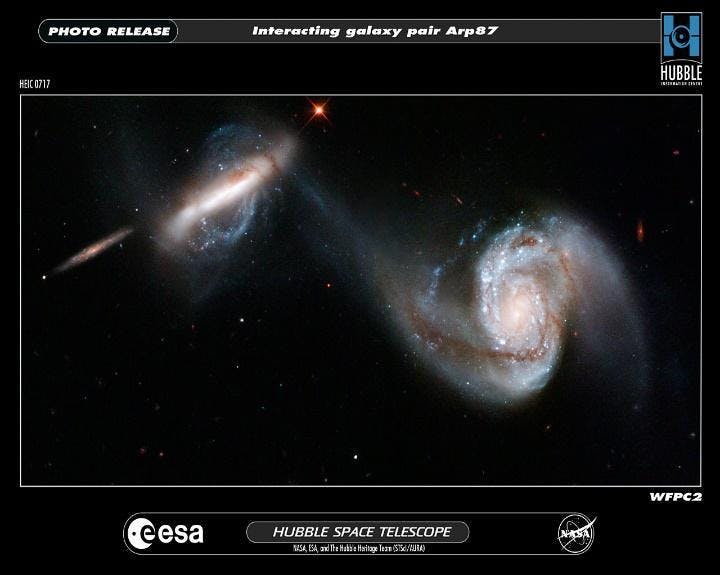
Interacting galaxies Arp87 in the Leo constellation.
NASA, ESA, and the Hubble Heritage Team
With the advent of larger telescopes, and the launch of space telescopes such as the Hubble Space Telescope astronomers were (and still are) able to explore more of the Universe and have looked beyond our neighboring galaxies. When Hubble was first pointed to observe a tiny, seemingly empty, piece of sky in the constellation of the Big Dipper (Ursa Major), nobody knew what to expect.

Illustration of the size of the deepest observations within the Hubble Space Telescope, labelled as XDF, in comparison to the apparent size of the full moon on the sky.
NASA, ESA, and Z. Levay (STScI), T. Rector, I. Dell'Antonio/NOAO/AURA/NSF, Digitized Sky Survey (DSS), STScI/AURA, Palomar/Caltech, and UKSTU/AAO
That tiny piece of empty sky, however, revealed more than 3000 galaxies!
When comparing these distant galaxies to those we see in the local universe, astronomers found that distant galaxies look very different. They are much more irregular, and often smaller and clumpy.
Since the speed of light is finite, the light from increasingly distant galaxies takes time to reach us. Consequently, the further away a galaxy is located from us, the further we look into the past. Take for example, the light from our own Sun; it takes eight minutes to reach the Earth. The Andromeda Galaxy, one of our close neighbors, is already 2.5 million light years away from the Milky Way. By observing distant galaxies, we observe how they appeared billions of years ago when the Universe was only a fraction of its current age of about 13.8 billion years. This makes observing the distant universe a great way to also study its history.
Astronomers still try to understand today, how the galaxies of the early universe grew, and how they evolved over time to become the smooth and regularly shaped Spirals and Ellipticals we observe in our cosmic neighborhood.
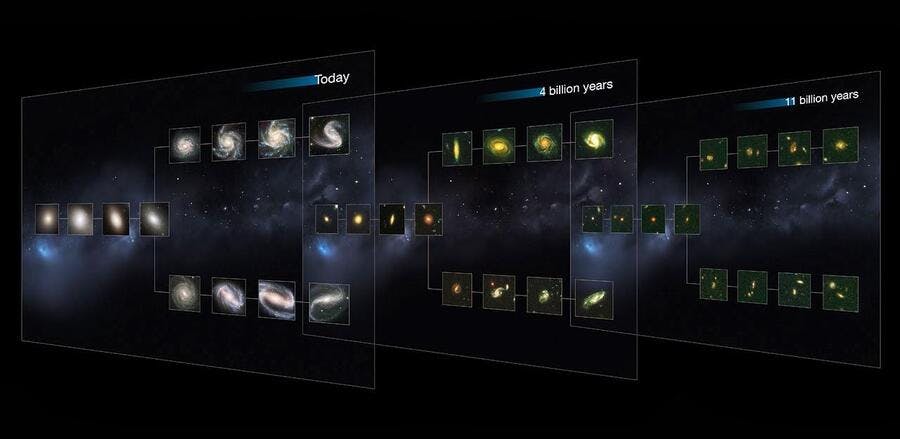
Three diagrams showing how galaxies at different ages of the universe looked like. On the left are galaxies as they appear today from elliptical to spiral galaxies sorted in the Hubble Tuning Fork Diagram. The middle figure shows galaxies as they appeared 4 billion years ago sorted into the same diagram. The right diagram shows the youngest galaxies from 11 billion years ago.
NASA, ESA, M. Kornmesser; the CANDELS team (H. Ferguson)
In order to find the very first galaxies in the universe, astronomers need new telescopes such as the James Webb Space Telescope (JWST). JWST is a collaboration between NASA, ESA, and the Canadian Space Agency to design and construct a successor to the Hubble Space Telescope.
Given the great strides that were made with Hubble Space Telescope observations, we can’t wait to see what new discoveries JWST will bring!
Get Updates By Email
This article was originally published on August 20, 2019.
- Space Exploration

Looking Back at When Star Trek Made Its Own Galaxy's Edge
Looking back at when star trek made its own galaxy's edge, as disney's parks celebrate a new season of the force with its star wars offerings, we look back at star trek 's own take on immersive experiences..
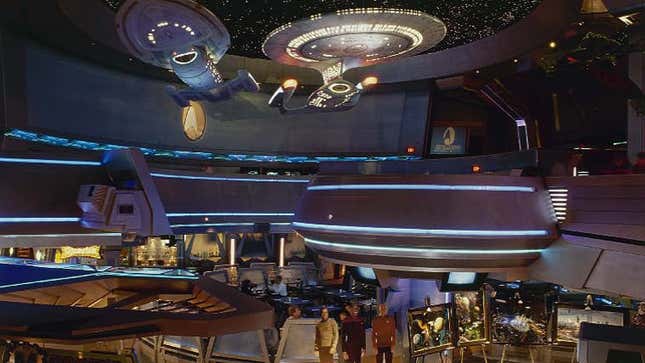
This month, Disney is celebrating the Season of the Force at its theme parks—new additions to Star Tours , character tweaks at Galaxy’s Edge , and more merch and snacks than you can wave a lightsaber at. It’s the apex of what the company has done with Star Wars at the parks so far... but a long time ago, in a galaxy closer to home, the other Star franchise of our hearts did its own bang up job.
We wrote about Star Trek: The Experience before, right when Galaxy’s Edge was preparing to open for the first time. But now that Batuu is firmly wedged into the world of Disney parks, and Star Trek itself has risen to new highs in its streaming renaissance , we wanted to take another walk down the promenade , and reminisce about the ultimate Star Trek immersive experience.
Enterprise , Las Vegas
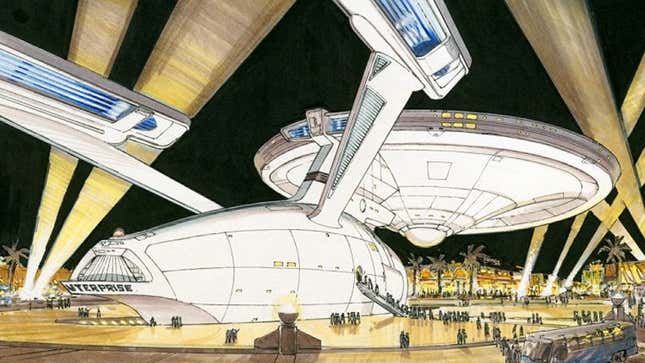
Plans for an extensive Star Trek attraction in Las Vegas were already underway in the early 1990s, when former Disney Imagineer Gary Goddard drew the interest of a consortium of downtown Las Vegas businesses with a wild pitch: build the USS Enterprise into a life-size, replica-meets-attraction-meets-restaurant that would’ve landed one of the most iconic sci-fi starships smack bang on Earth itself.
While the local businesses and government were energized by the idea, one person at Paramount was less so—arguably the most important of all, Paramount president Stanley Jaffe. Jaffe killed the pitch almost immediately, fearing that if the Enterprise venue failed, due to its sheer scope it would still remain standing after it closed its doors: a living, Constitution-class-shaped reminder of his failure.
The Experience Begins
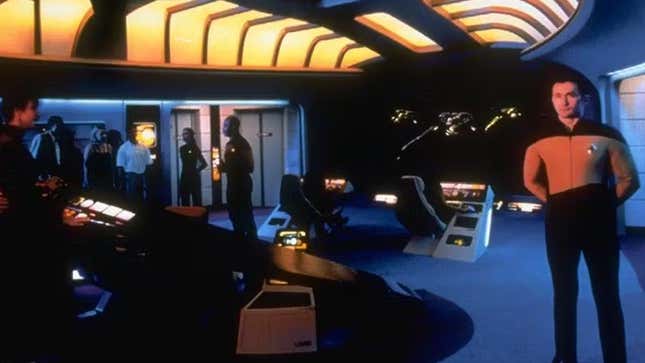
But Goddard’s dream wasn’t quite dead. A few years later, he was approached by the Las Vegas Hilton Hotel—which had already gotten Paramount on board for a Star Trek project designed to bring people to the hotel’s off-strip location and into its own casinos. There was also already a basic idea in place: visitors would come, be beamed away on a Star Trek mission, and put back on Earth after the adventure.
Although much less grand in scope than a ginormous Enterprise , Goddard got to work on something still wildly ambitious. What would become Star Trek: The Experience when it opened in 1998 was more than just that kernel of an idea about beaming away on a mission: visitors would walk through a museum display charting the path from NASA to Starfleet, be beamed to the Enterprise -D for a time-twisting adventure and simulator ride, and then be plonked back in Vegas’ very own replica of Deep Space Nine, teeming with shops, food, and of course, Star Trek aliens and officers milling around in character.
Klingon Encounter
That adventure was “Klingon Encounter”—instead of being immediately put onto a simulator ride, guests would be “beamed” up through an incredible light and motion trick , with moving wall panels and gushes of air, and brought onto a full replica of the bridge of The Next Generation ’s Enterprise -D. Not unlike how, say, Galaxy’s Edge ’s second main ride, Rise of the Resistance , tricks people into thinking they’ve gotten onto a transport ship and physically moved to the confines of a Star Destroyer from their earthly travels, it would be in this setting that pre-recorded messages from Jonathan Frakes’ Will Riker would tell visitors that one of their number was in fact a direct descendant of Jean-Luc Picard—and that the Klingons were trying to manipulate time and erase the Enterprise captain from existence by eliminating his family line.
From there, visitors would move through the Enterprise ’s hallways, into a turbolift attacked by Klingon saboteurs, and only then actually onto the ride itself—a simulator “shuttlecraft” with Geordi LaForge, taking them back to their home time and actually back over and into Las Vegas itself, selling the feeling of actually having travelled through time and space. After a farewell message from Picard “Klingon Encounter” dumped you back on Earth... of a sorts.
Welcome to Deep Space Nine
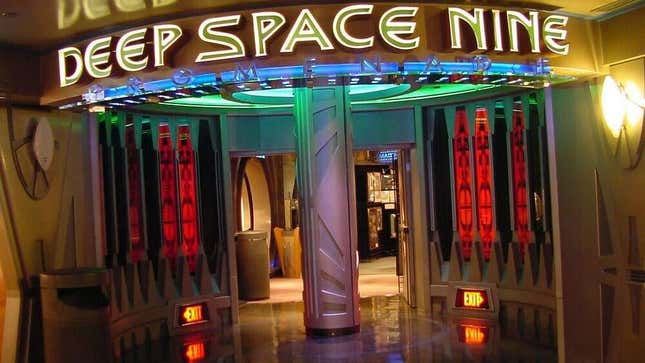
What actually awaited people as a hop and skip over to the next Star Trek show: Deep Space Nine . A replica of a section of the space station’s promenade—both floors of the circular ring were made, although the second remained inaccessible for the best part of a decade, until it was opened up to visitor access to a captain’s lounge-style venue area—became home to a series of themed Star Trek gift shops, and even a restaurant.
A Trip Down the Promenade...

The promenade’s offerings weren’t a 1:1 recreation of the show, of course—there were no jumja stick vendors, or the Replimat to grab a raktajino at. Instead, there were six different stores, a tribute to the might of Ferengi commerce:
- Moogie’s Trading Post, named for Quark and Rom’s mother, which sold merchandise exclusive to The Experience as well as starship replicas and other Star Trek merchandise,
- The Admiral Collection, a high-end props and replica store selling licensed costumes and masks, as well as art,
- The Molecular Imaging Scanner, a photobooth that let visitors put themselves into Star Trek scenes and locales,
- Latinum Jewelers, selling, of course, jewelry,
- Zek’s Grand Emporium, named for the Ferengi Grand Nagus, which sold general Star Trek merchandise,
- Garak’s Clothiers, named for the plain, simple Cardassian tailor, which sold Star Trek -themed clothing...
... And Dinner at Quarks

After all that shopping and being nearly murdered by Klingons, people were probably hungry—so it’s a good job the Promenade included its most famous DS9 establishment, Quark’s. Although you couldn’t have a round or six of Tongo and Dabo in there, Quark’s sold Star Trek- themed food and drinks. Although mostly Trek -themed via pun names rather than attempts to replicate iconic snacks from the series— the Holy Onion Rings of Betazed, anyone? —there were a few actually inspired by the shows, like the Warp Core Breach cocktail, and of course, Saurian Brandy.
The Borg Invasion
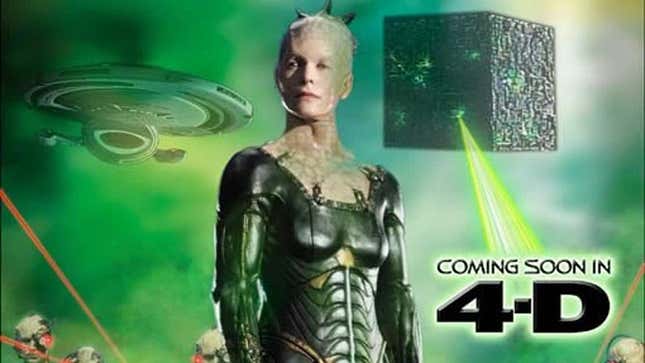
In 2004, the experience expanded to finally incorporate the third of the ‘90s Trek shows with “Borg Invasion 4D.” Although not as immersively themed as “Klingon Encounter,” the ride still featured elements of live-action actors as well as recorded clips from Voyager stars Kate Mulgrew, Alice Krige, and Robert Picardo as Captain Janeway, the Borg Queen, and Voyager ’s holographic Doctor, respectively—as visitors were taken to Copernicus Station to undergo tests for a supposed immunity to Borg nanotechnology, only to find themselves assaulted by a Borg Cube and whisked away (via 3D simulator rides, of course) to safety.
End of the Road
But by the time “Borg Invasion 4D” arrived, The Experience was on its way out. Reduced budget cut down the amount of actors used in both the rides and milling about the Promenade, and with Star Trek interest waning on screen as Enterprise came to an end, it was announced that by the end of 2008, The Experience would close its doors for good—ironically, a year before Star Trek returned to the big screen in the J.J. Abrams “Kelvin Timeline” reboots.
Just as it lived, the venue died in Star Trek themed fashion: it wasn’t just closed, but given a Starfleet decommissioning ceremony, where it was announced that props and replicas used in The Experience would be relocated to a new home at the downtown strip mall Neonopolis. But plans fell through, and most of what was once shown at Star Trek: The Experience went into the hands of private collectors, auctioned off in the years since. And while the attraction itself is gone, it does leave a peculiar legacy: elements of the sign advertising the experience, including the Starfleet delta badge, are still standing on the side of the Hilton.
The Final Frontier?
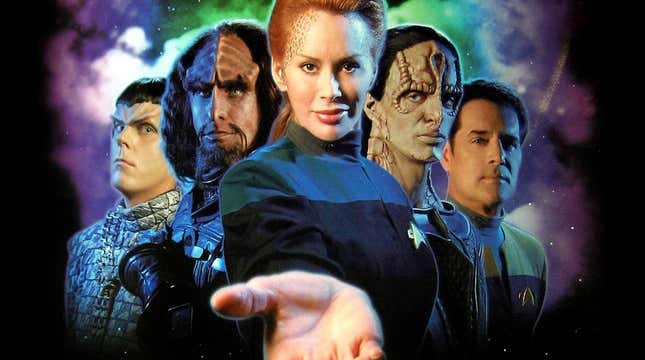
But now, Star Trek finds itself in a very different place to where it was when The Experience shuttered in 2008. Although the year after Trek returned to the big screen, it’d take almost another decade for the franchise to take the voyage home to TV with Star Trek: Discovery , anchoring the launch of Paramount’s nascent streaming service (known then as CBS All Access). Now, there’s more Star Trek than there ever was in its ‘90s heyday, and yet more on the horizon.
After Galaxy’s Edge has proven this kind of immersive experience can still thrive (and, in the case of Galactic Starcruiser, how not to do it ), could Star Trek sustain the idea again? It’s hard to say what form such a thing could take. Would it embrace the nostalgia of the beloved ‘90s shows and essentially re-do what The Experience did? Would it theme itself around the modern offerings? There’s no solid plans for such a thing yet either way... but it’s nice to dream that Star Trek could match Star Wars with such a thing, a quarter century after it beat it to the punch in the first place.
'Star Trek: Discovery' season 5 episode 5 'Mirrors' is a quality installment, but weighed down by another anchor of nostalgia
This entire episode was more than likely written for the sole reason that the sets from "Strange New Worlds" could be utilized.

Warning: Spoilers ahead for "Star Trek: Discovery" season 5, episode 5
The chase across the galaxy for the Progenitors MacGuffin continues, offering chances to insert stand-alone, episode-length adventures along the way. And this week's installment, entitled "Mirrors" features a brief and very random reminder that the Mirror Universe exists.
And that alone would've made an genuinely enthralling episode, but...Alex Kurtzman et al could not resist the temptation for an utterly pointless and thoroughly unnecessary throwback to the USS Enterprise. Honestly, these people have a serious problem, they should seek help.
To put all of this into context, the crew of the USS Discovery continue their pursuit of Malinne 'Moll' Ravel (Eve Harlow) and L'ak (Elias Toufexis) and that chase leads them to er...well, you know, a giant, space-time swirly orifice that fills the viewscreen. Apparently, it's some sort of wormhole that's spectacularly unstable because of the constant matter/anti-matter reactions that are taking place at the opening. It's actually more than a little reminiscent of the inside of the V'ger spacecraft from "Star Trek: The Motion Picture" and that's just fine.

Watch Star Trek on Paramount Plus: Get a one month free trial
Get all the Star Trek content you can possibly handle with this free trial of Paramount Plus. Watch new shows like Star Trek: Discovery and all the classic Trek movies and TV shows too. Plans start from $4.99/month after the trial ends.

But it's what they find inside that grinds gears. Since the Discovery is too big to squeeze through the constantly opening and closing orifice, Capt. Burnham (Sonequa Martin-Green) and Book (David Ajala) take a shuttle through only to find...the ISS Enterprise. Yes, indeed, last seen (and only seen, actually) in the epic "The Original Series" episode "Mirror, Mirror" (S02, E04).
While beaming back to the USS Enterprise during an ion storm, Kirk, McCoy, Scotty and Uhura materialize aboard a almost-identical Enterprise in a parallel universe. Here, the United Federation of Planets has been replaced by the Terran Empire and its inhabitants are violent and cruel. Their only hope is to artificially reproduce the effects of the storm to facilitate a return to their own universe. (" I mperial S pace S hip replaces the traditional " U nited S pace S hip.")
And while the idea of finding a derelict, 900-year-old starship from the latter half of the 23rd century is a great idea, in the name of the Great Prophet Zarquon, why-oh-why did it have to be the Enterprise? There are — at least — 10 other Constitution Class starships that could've been potentially chosen and thus still allowing the updated sets from "Strange New Worlds" to have been used.
Get the Space.com Newsletter
Breaking space news, the latest updates on rocket launches, skywatching events and more!

The USS Cayuga (NCC-1557), USS Constellation (NCC-1017), USS Defiant (NCC-1764), USS Excalibur (NCC-1664), USS Exeter (NCC-1672), USS Hood (NCC-1703), USS Intrepid (NCC-1631), USS Lexington (NCC-1709), USS New Jersey (NCC-1975) and the USS Potemkin (NCC-1657). And those are just the ones that are canon. Another new vessel could just as easily have been introduced as it's not unknown for Nu-Trek to bring brand new ships to the line.
And of course Burnham makes reference to the fact that her brother, Spock, served on this ship, which is probably another reason why the Enterprise was forced upon the writers. And according to some extremely rushed exposition, most of the crew escaped the weird wibblywobbly wormhole and went on to lead peaceful and productive lives — we assume somewhere not too far away given how long ago it happened and the current location in deep space — in a somewhat Space Seed scenario. Another interesting throwaway remark from Burnham was, "Crossing between universes has been impossible for centuries now," which shuts down that potential story avenue rather abruptly.
But let's also focus on why this episode could've been near-faultless if only someone could counsel Paramount showrunners on how to ween themselves off of nostalgia addiction. This week we get to see the whole Moll and L'ak backstory...and it's rather good and to add to that, Book and Moll confront the fact that they're distantly related. You know, because that makes things much more absurd orderly. (See how Burnham had to be related to Spock.)
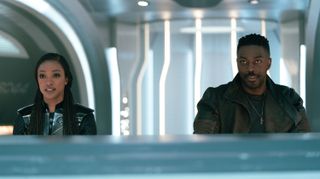
The pacing of this episode, and with the exception of using the Enterprise, when any other Constitution Class starship could've worked — and served to expand the Mirror Universe a little bit — this is an enjoyable episode. It's a shame though that this is following the same cookie cutter seasonal storyline template by relying very much on a quest to follow while having standalone episode-long adventures to fill in the gaps, but hey, it can't be much worse than last season. So, there's that.
The fifth and final season of "Star Trek: Discovery" and every other episode of every "Star Trek" show — with the exception of "Star Trek: Prodigy" — currently streams exclusively on Paramount Plus in the US, while "Prodigy" has found a new home on Netflix.
Internationally, the shows are available on Paramount Plus in Australia, Latin America, the UK and South Korea, as well as on Pluto TV in Austria, France, Germany, Italy, Spain and Switzerland on the Pluto TV Sci-Fi channel. They also stream on Paramount Plus in Italy, France, Germany, Switzerland and Austria. In Canada, they air on Bell Media's CTV Sci-Fi Channel and stream on Crave.
Join our Space Forums to keep talking space on the latest missions, night sky and more! And if you have a news tip, correction or comment, let us know at: [email protected].

When Scott's application to the NASA astronaut training program was turned down, he was naturally upset...as any 6-year-old boy would be. He chose instead to write as much as he possibly could about science, technology and space exploration. He graduated from The University of Coventry and received his training on Fleet Street in London. He still hopes to be the first journalist in space.
Everything we know about James Gunn's Superman
This Week In Space podcast: Episode 108 — Starliner: Better Late Than Never?
Mars exploration, new rockets and more: Interview with ESA chief Josef Aschbacher
Most Popular
- 2 Everything we know about James Gunn's Superman
- 3 Sneak peek: Browncoats grab victory in Boom! Studios' upcoming 'Firefly: 'Verses' comic (exclusive)
- 4 SpaceX launching 23 Starlink satellites from Florida this evening
- 5 NASA's mission to an ice-covered moon will contain a message between water worlds

Hubble Captures a Bright Galactic and Stellar Duo

This image from the NASA/ESA Hubble Space Telescope features NGC 3783, a bright barred spiral galaxy about 130 million light-years from Earth that also lends its name to the eponymous NGC 3783 galaxy group. Like galaxy clusters, galaxy groups are aggregates of gravitationally bound galaxies. Galaxy groups, however, are less massive and contain fewer members than galaxy clusters do: whereas galaxy clusters can contain hundreds or even thousands of constituent galaxies, galaxy groups do not typically include more than 50. The Milky Way is actually part of a galaxy group, known as the Local Group, which also holds two other large galaxies (Andromeda and the Triangulum galaxy), as well as several dozen satellite and dwarf galaxies. The NGC 3783 galaxy group contains 47 galaxies. It also seems to be at a fairly early stage of its evolution, making it an interesting object to study.
While the focus of this image is the spiral galaxy NGC 3783, the eye is equally drawn to the very bright object in the lower right part of this image. This is the star HD 101274. The perspective in this image makes the star and the galaxy look like close companions, but this is an illusion. HD 101274 lies only about 1,530 light-years from Earth, it is about 85,000 times closer than NGC 3783. This explains how a single star can appear to outshine an entire galaxy!
NGC 3783 is a type-1 Seyfert galaxy, which is a galaxy with a bright central region. Hubble captures it in incredible detail, from its glowing central bar to its narrow, winding arms and the dust threaded through them, thanks to five separate images taken in different wavelengths of light. In fact, the galactic center is so bright that it exhibits diffraction spikes, normally only seen on stars such as HD 101274.
Text credit: European Space Agency (ESA)
Media Contact :
Claire Andreoli NASA's Goddard Space Flight Center , Greenbelt, MD [email protected]
Related Terms
- Goddard Space Flight Center
Hubble Space Telescope
- Seyfert Galaxies
- Spiral Galaxies
- The Universe
Discover More Topics From NASA
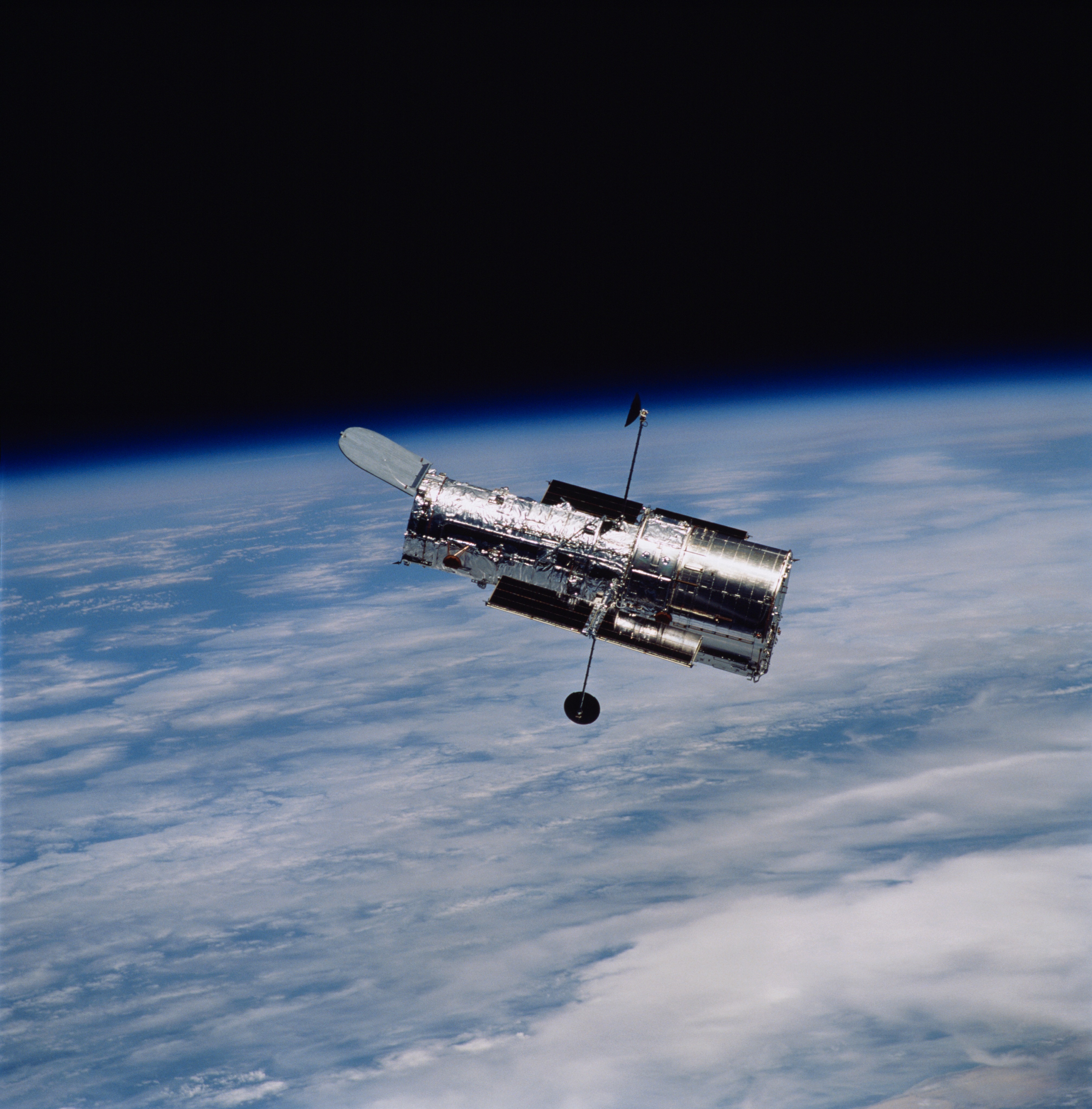
Galaxies Stories
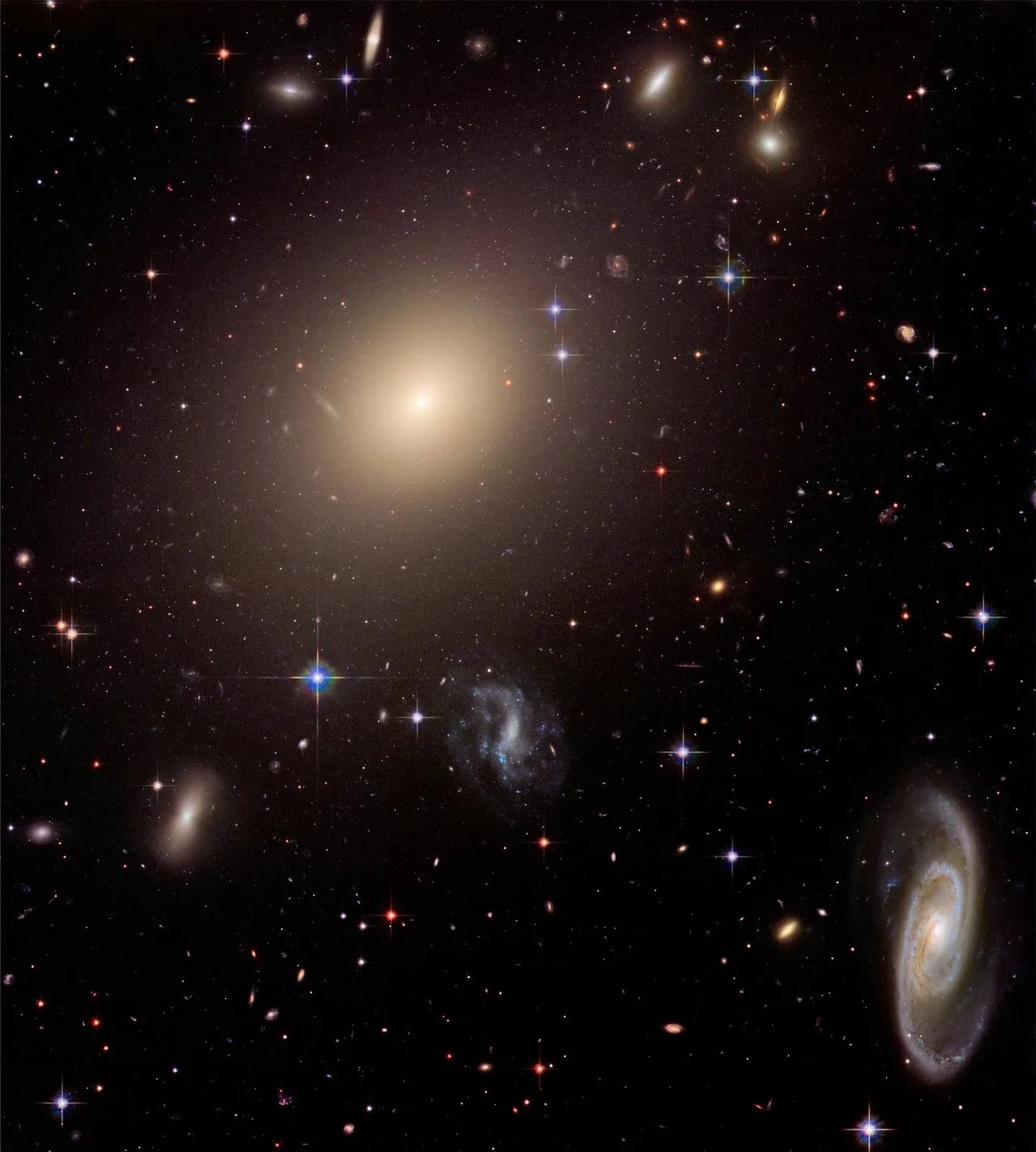
Asteroids, Comets, and Meteors Stories
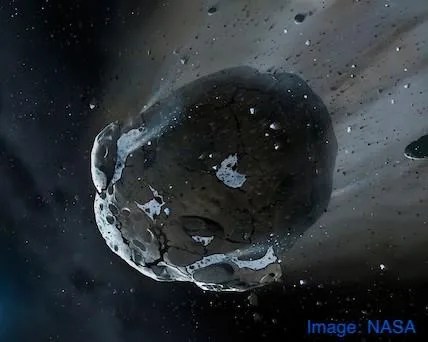
Stars Stories
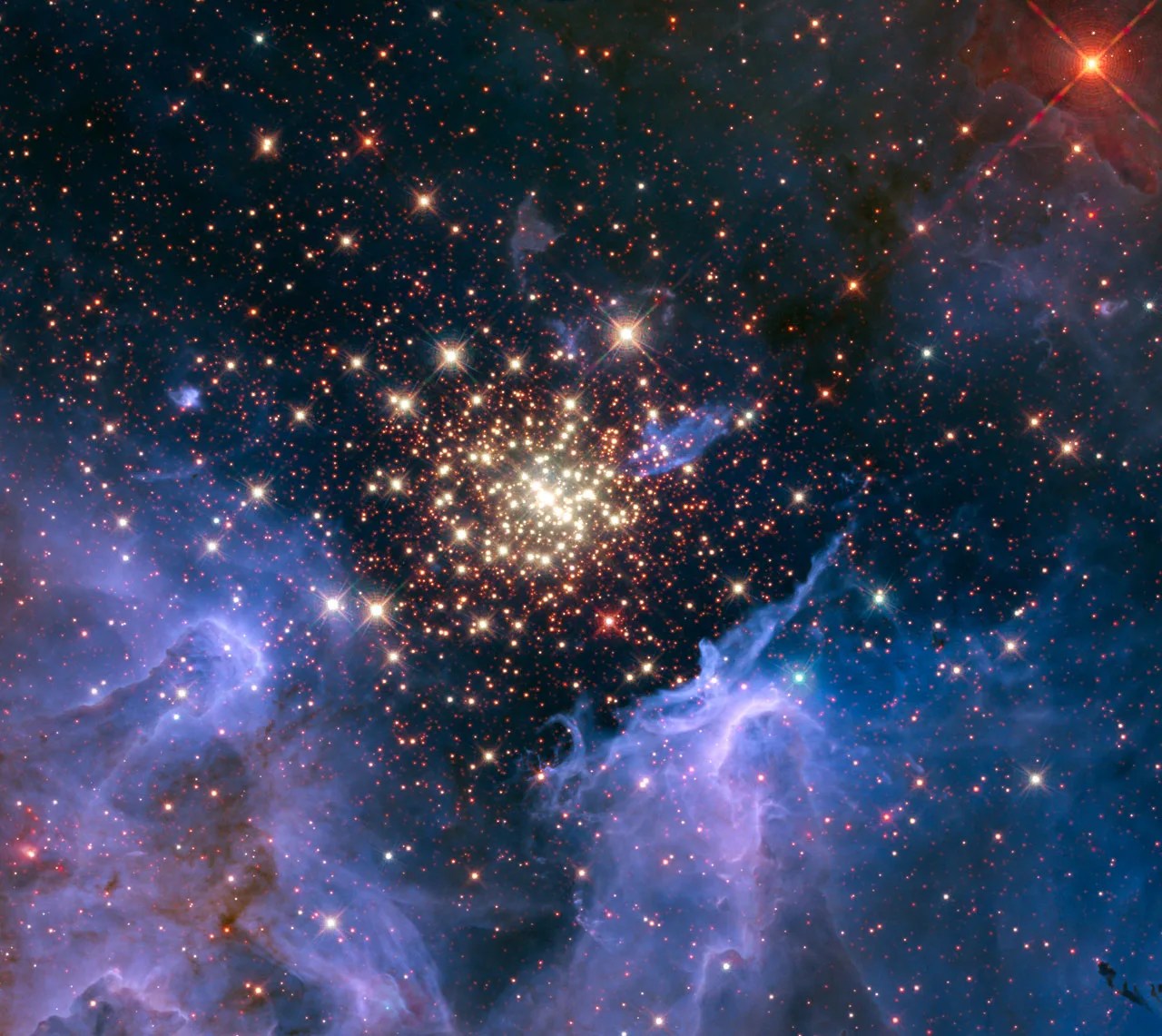
Screen Rant
Star trek: discovery’s 4 number ones explained.
Star Trek: Discovery has had four different Number Ones over the course of its five seasons, including Captain Michael Burnham.
- Star Trek: Discovery features a rotating cast of Captains and Number Ones, showcasing dynamic leadership changes throughout the series.
- Characters like Saru, Burnham, Tilly, and new addition Rayner bring diverse personalities and skills to the USS Discovery crew.
- The evolution of these key roles, from First Officer to Captain, demonstrates the growth and adaptability of each character over the seasons.
Just as Star Trek: Discovery has featured several different Captains of the USS Discovery throughout its five-season run, the show has also introduced four different Number Ones. Since its beginning, Discovery has been less of an ensemble show than previous Star Trek series, and the crew of the USS Discovery has been constantly shifting. Discovery tells the story of Michael Burnham (Sonequa Martin-Green), who has gone from being an accomplished First Officer to a notorious criminal to the Captain of Discovery. Burnham has filled the position of Number One more than once, and two of her best friends have also taken on that role.
Ambassador Saru (Doug Jones) and Lt. Sylvia Tilly (Mary Wiseman) have both served as First Officers of the USS Discovery, although their careers have since taken them in different directions. In Star Trek: Discovery season 4, the show found a dynamic that worked well, with Burnham as Captain and Saru as her First Officer. But Discovery can never go too long without shaking things up, and Callum Keith Rennie's Commander Rayner did just that when he joined the cast of Star Trek: Discovery season 5 . As Captain Burnham's newest Number One, Rayner has proven to be a great addition to Discovery's crew, despite (and also because of) his gruff, no-nonsense command style.
Every Star Trek Discovery Captain In All 5 Seasons
4 commander/captain saru, under the command of captain gabriel lorca & captain michael burnham.
During the two-part premiere of Star Trek: Discovery, Saru was serving as the Chief Science Officer on the USS Shenzhou, under the command of Captain Philippa Georgiou (Michelle Yeoh). After Commander Burnham committed mutiny and Captain Georgiou was killed, Saru was promoted Commander and became First Officer on the USS Discovery, under the command of Captain Gabriel Lorca (Jason Isaacs) . Although Saru had not yet gained the confidence he would in later seasons of Star Trek: Discovery , he proved to be a capable and compassionate First Officer.
Saru took over command of the USS Discovery after Lorca was revealed to be from the Mirror Universe, and he shared "joint custody" of the ship with Captain Christopher Pike (Anson Mount) for most of Star Trek: Discovery season 2.
Saru commanded the USS Discovery for its journey to the 32nd century, and he was promoted to Captain. Saru later took time away from Starfleet to become a member of the village council on his homeworld of Kaminar. After the Dark Matter Anomaly destroyed Kwejian, Saru returned to Discovery as Captain Burnham's First Officer, retaining the rank of Captain but choosing to go by the designation Mr. Saru. As the first Kelpien in Starfleet, Saru had already made history , but in Star Trek: Discovery season 5, Saru accepted a position as a Federation Ambassador, adding another achievement to his impressive resume.
3 Commander Michael Burnham
Under the command of captain philippa georgiou & captain saru.
When Star Trek: Discovery began, Commander Burnham was serving as the First Officer on the USS Shenzhou, under the command of Captain Georgiou. After her subsequent mutiny, Burnham served six months in prison before transferring to the USS Discovery, where Captain Lorca assigned her as a Specialist in the science division. After Michael helped end the Federation/Klingon War, she was fully reinstated as a Commander and became Chief Science Officer on Discovery. At the end of Star Trek: Discovery season 2, Burnham wore the Red Angel suit to lead the USS Discovery into the 32nd century.
Michael Burnham was a fine First Officer (aside from the whole mutiny thing), but she truly excels at being a Starfleet Captain.
Captain Burnham arrived in the future a year before Discovery, but she later reconnected with her former crew and reluctantly accepted the role of Captain Saru's Number One. Michael served as First Officer throughout Star Trek: Discovery season 3, until she helped take the ship back from Osyraa (Janet Kidder), the leader of the Emerald Chain. Saru then suggested that Burnham take over as Captain , and Admiral Charles Vance (Oded Fehr) assigned Michael as Captain of the USS Discovery. Michael Burnham was a fine First Officer (aside from the whole mutiny thing), but she truly excels at being a Starfleet Captain.
With its time travel plot that saw Captain Burnham run into her past self, Star Trek: Discovery season 5, episode 4, "Face the Strange," illustrates just how far Michael has come since Discovery season 1.
2 Lt. Sylvia Tilly
Under the command of captain saru & captain michael burnham.
Sylvia Tilly began her Star Trek: Discovery career as a cadet aboard the USS Discovery under the command of Captain Lorca. After the end of the Klingons' War with the Federation , Tilly was promoted to Ensign and was placed on the command track. She continued on this trajectory until Discovery traveled into the future. When Captain Saru demoted Burnham for insubordination, he asked Tilly to be his First Officer. Although she was initially reluctant to take the job, fearing others on the ship were better qualified, Tilly's fellow crew members assured her she was the right choice as Number One.
After Commander Burnham helped take the USS Discovery back from Osyraa and became Captain, Tilly remained First Officer and was promoted to Lt. junior grade. Tilly then began to question whether she wanted to remain on the command track, and spoke with Dr. Hugh Culber (Wilson Cruz) about ways she could step out of her comfort zone. Culber recommended Tilly for a mission that involved leading a group of young Starfleet cadets. Although the mission quickly turned dangerous, Tilly successfully coached the cadets through it, and she later accepted a teaching position at the recently reopened Starfleet Academy.
Star Trek: Discovery Proves Starfleet Academy Show Doesn’t Make Sense Without Tilly
1 commander rayner, under the command of captain michael burnham.
Callum Keith Rennie's Commander Rayner joined the cast of Star Trek: Discovery for its fifth and final season, and the gruff former Captain has proven to be a breath of fresh air. In Discovery's season 5 premiere, Rayner held the rank of Captain and commanded the USS Antares, but was asked to accept early retirement after making a questionable call during a Red Directive mission. Captain Burnham, however, asked Rayner to be her new First Officer after Saru accepted a position as a Federation Ambassador.
Commander Rayner has proven invaluable to Discovery's mission and remains a highlight of Star Trek: Discovery season 5.
As a Kellerun, Commander Rayner's personality contrasts sharply with the more optimistic crew of the USS Discovery, and his command style is very different from Burnham's. Rayner has struggled to relate to Discovery's crew members and adapt to Michael's command style , but his advice and knowledge have helped save the day on multiple occasions. As Discovery races against couriers Moll (Eve Harlow) and L'ak (Elias Toufexis) to find the Progenitors' treasure, Commander Rayner has proven invaluable to the mission and remains a highlight of Star Trek: Discovery season 5.
New episodes of Star Trek: Discovery stream Thursdays on Paramount+.
Star Trek: Discovery

Star Trek: Discovery Finally Gave Us A Closer Look At The Franchise's Most Mysterious Villain
Warning: This article contains spoilers for the latest episode of "Star Trek: Discovery."
"Star Trek" might represent an idealistic vision of a bolder and brighter future, but the last few seasons of "Discovery" have proven that there will always be bad guys with a penchant for muddying up those ambitions in unexpected ways -- even in the 32nd Century. While the Borg, Romulans, and the warlord Khan often have a stranglehold on the title of "Best 'Trek' villains," one alien species in particular has remained shrouded in mystery for decades. First mentioned in foreboding whispers in "The Next Generation" and finally seen in the flesh (well, so to speak) in "Star Trek: Deep Space Nine," the Breen have played a significant role throughout the franchise in the years since ... yet Trekkies still had to wait until now to actually see what lies underneath their distinctive helmets.
The advantage of never showing us a Breen's face, as it turns out, is that "Discovery" was able to hide one in plain sight all along.
So far, the addition of scavengers Moll (Eve Harlow) and L'ak (Elias Toufexis) has felt like a shoe waiting to drop. The close-knit pair continue to frustrate Captain Michael Burnham (Sonequa Martin-Green) and the rest of the Discovery crew (nowhere more dramatically than in last week's time-traveling bottle episode ), remaining one step ahead of our heroes in their quest to recover whatever Progenitor technological treasure hides at the end of this galaxy-spanning rainbow. About midway through episode 5, titled "Mirrors," the writers unleashed their big twist. L'ak, thus far considered an unknown type of extraterrestrial, actually reveals himself as a Breen. Or, rather, an emotional Moll lets this information slip by accident during a particularly fraught moment. In the process, "Trek" finally unmasked its most enigmatic aliens.
Read more: Every Star Trek Show And Movie In Chronological Order
Putting On A Brave Face (Or Two)
In the span of one episode, "Discovery" officially made "Star Trek" history.
Long treated as a mystery that left everything up to our own imaginations, the Breen reveal puts a specific face to what had previously only been a name ... actually, make that two faces. While Moll and L'ak come to a tense faceoff with Burnham and Cleveland Booker (David Ajala) on board the mirror-universe version of the USS Enterprise while trapped in multidimensional space (it's a long story), the writers treat this as the perfect opportunity to delve into the scavengers' shared past. In a series of flashbacks, we find out that L'ak was part of the Breen royal family and disgraced by his powerful Primarch uncle. Hoping to earn his way back to his people's good graces, all his plans are upended by a torrid romance with then-courier Moll. With their backs against the wall and nowhere else to turn, the lovers choose their own path altogether and, along the way, L'ak reveals his most private aspect of himself: his Breen face.
Of course, the episode adds another twist and introduces the concept of the Breen having two faces -- a solid, corporeal form they can present to others if they so choose, and a more translucent one. (Really, it can only be described as squishier. ) In fact, this creepy and altogether unique visage symbolizes a much more meaningful difference, as we learn when L'ak's uncle calls his chosen face an "insult to your heritage." Apparently, most Breen have moved beyond this "weak" form and consider this some sort of societal faux pas. In just a few minutes, we discover more about Breen culture than we've ever known before.
New episodes of "Star Trek: Discovery" stream every Thursday on Paramount+.
Read the original article on SlashFilm
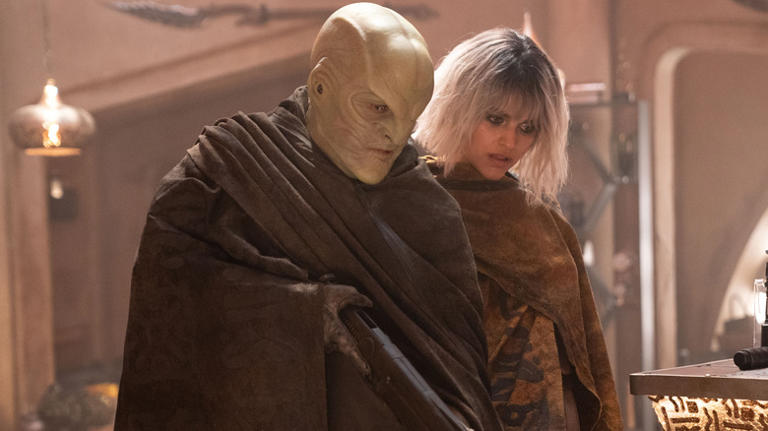

USS Venture (NCC-71854)
- View history
The USS Venture (NCC-71854) was a 24th century Federation Galaxy -class starship operated by Starfleet . Its captain was a friend of Benjamin Sisko .
In 2372 , the Venture led a task force under the command of Admiral Hastur to reinforce Deep Space 9 when it was threatened by a Klingon attack . Sisko offered to talk to the captain of the Venture to secure Worf a position aboard, although Worf preferred to stay on Deep Space 9. ( DS9 : " The Way of the Warrior ")
The Venture visited DS9 again in 2373 . ( DS9 : " Doctor Bashir, I Presume ")
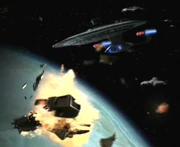
The Venture destroys a Cardassian orbital weapon platform
In 2374 , the Venture participated in Operation Return , protecting the flank of the USS Defiant . The Venture was one of the first ships to arrive at Deep Space 9 after the Dominion retreat. ( DS9 : " Sacrifice of Angels ")
The Venture saw action again later that year when it fought as part of the Federation Alliance fleet that invaded the Chin'toka system . ( DS9 : " Tears of the Prophets ")
By 2401 , this ship had been superseded by a Sovereign -class USS Venture . ( PIC : " The Star Gazer ")
- 1.1 Appearances
- 1.2 Background information
- 1.3 Apocrypha
- 1.4 External link
Appendices [ ]
Appearances [ ].
- " The Way of the Warrior "
- " Doctor Bashir, I Presume "
- " Sacrifice of Angels "
- " Tears of the Prophets "
Background information [ ]
The Venture in "The Way of the Warrior" (and episodes which reused that footage) was the four-foot USS Enterprise -D model built for the third season of Star Trek: The Next Generation . Although it was mostly unchanged from the Enterprise -D, the Venture retained the phaser arrays on the dorsal sides of its nacelles from when the model was modified into the future Enterprise from TNG : " All Good Things... ", but they were turned around for the Venture. This was the last use of the four-foot physical model to represent the Galaxy -class, although AMT kits would be used later as well as computer generated versions that did not have the extra phasers.
The Venture 's appearance in "Tears of the Prophets" was confirmed by John Gross and Karen Sickles of Digital Muse in a 25 June 1998 post, by DS9 Visual Effects Supervisor David Stipes , on the newsgroup alt.tv.star-trek.ds9 .
The Venture was also the first Galaxy -class ship to have its full name emblazoned below the registry number on the ventral side of its saucer section , [1] (X) which was carried over to other Galaxy -class ships such as the USS Challenger from VOY : " Timeless ".
Apocrypha [ ]
In the strategy game, Star Trek: Bridge Commander , the USS Venture was one of the ships the player has to rescue from a Cardassian attack.
In Star Trek Online , the Venture has been destroyed or decommissioned by 2409 and replaced by a Venture -class ( β ) starship, NCC-71854-A ( β ); this ship was subsequently lost attempting to halt a Borg incursion into fluidic space .
External link [ ]
- USS Venture (NCC-71854) at Memory Beta , the wiki for licensed Star Trek works
- 3 ISS Enterprise (NCC-1701)

IMAGES
VIDEO
COMMENTS
The Star Trek galaxy explained that apart from the Romulans and the different versions of the Klingons, the Beta Quadrant's highlight is Vulcan, the native planet of Spock and other members of the Vulcan species.Multiple Star Trek encyclopedias suggest that Vulcan is located in a Sector of the same name within the Beta Quadrant. The 2002 publication Star Trek Charts also estimates Vulcan's ...
On some Star Trek maps of the center of the galaxy, the galactic core is regarded as its own area, ... In the Star Trek universe, a neutral zone is a sort of "buffer zone" between the territories of two different powers; if either party enters a neutral zone, it is considered an aggressive move (usually an act of war).
In Star Trek, the galaxy is divided into four main quadrants: Alpha, Beta, Gamma, and Delta. Each quadrant contains different planets, species, and civilizations that the show's characters explore and interact with. This article will delve deeper into the concept of quadrants in Star Trek, exploring what they are, how they work, and why they ...
The map above is Shakaar's Alpha/Beta map v3.3; a fan-made creation showing the Alpha and Beta quadrants of the Star Trek universe. The map shows both major and minor powers that have appeared in the various series over the years. At the centre is the United Federation of Planets, which borders the major power of the Klingon Empire, Roman ...
Star Trek: Star Charts is a guide to the Star Trek universe - the stars and planets of the United Federation of Planets and the other powers of the Milky Way Galaxy. It includes background information on the classification systems used for identifying stars and planets. Star Trek: Star Charts was announced in April 2002. [1] From the book jacket "…all I ask is a tall ship, and a star to ...
The Milky Way Galaxy was one of two trillion galaxies believed to exist. The number of stars it contained was variously estimated to be over three billion to over four hundred billion stars. It generated its own magnetic field, which experienced dips and peaks. The galaxy was 100,000 light years wide. (TNG: "Pen Pals"; VOY: "Inside Man"; ENT: "Azati Prime"; PIC: "Absolute Candor") The Milky ...
on The Map Room blog The Map Room Star Trek. put to print or screen. Star Trek. Memory Alpha. Star Trek Star Trek Star Trek: Deep Space Nine. Learn more. With the third season of 'Star Trek ...
2.1.1 The subdivision of the Galaxy. While in our time, we haven't ventured deep enough into space to need other systems for the exact determination of positions within our incredibly large galaxy than the equatorial and galactic coordinate systems, in the world of Star Trek, in which the interstellar navigation is the basis of trade, politics and the everyday life of billions of people, a ...
Map of the Galaxy Select a quadrant to view ... Buy the book at Amazon.com Star Trek Star Charts: The Complete Atlas of Star Trek ... Star Trek Star Charts: The Complete Atlas of Star Trek =/\\= Today is Stardate 77782.3 E-mail questions or comments ...
Star Trek: Picard season 1's synthetic villains, who were deathly feared by the Romulan Zhat Vash, originated from another galaxy beyond the Galactic Barrier. Briefly glimpsed in Star Trek: Picard season 1's finale, the synthetic beings have tentacled arms and they intended to wipe out all organic life in the galaxy.However, the synthetic villains used a wormhole to enter the Alpha Quadrant ...
Most of the action in Star Trek takes place in the real-world Milky Way Galaxy which is roughly divided into four quadrants, named after the first four letters of the Greek alphabet: Alpha, Beta, Gamma, and Delta. These are the galactic regions that include significant planets like Vulcan, Qo'noS, and of course, Earth. While Gamma and Delta still bear planets with ominous origins, the Alpha ...
Star Trek. The galactic barrier was an energy field composed of negative energy surrounding the rim of the Milky Way Galaxy. Invisible to both the naked eye and visual recording equipment at a distance, at close range the barrier shone with a purple- to pink-colored glow. No form of transmission was known...
Summary. The Galactic Barrier in Star Trek is a negative energy field at the edge of the Milky Way Galaxy that disrupts starships and human bodies. Captain Kirk encountered the Galactic Barrier multiple times in Star Trek: The Original Series but never crossed to the other side. In Star Trek: Discovery, Captain Burnham and her crew crossed ...
no. there's an episode on TOS where they leave the galaxy briefly. 5. [deleted] • 13 yr. ago. There were a few episodes where the ships got flung out into other galaxies, but most of them took place within the Milky Way. According to Trek lore, only about 17% or so of the Milky Way had been explored by the Federation.
Enterprise. Maquis. Augments Last, but certainly not least, these genetically engineered humans were the impetus for the Eugenics Wars of 20th-century Earth. After a devastating conflict that claimed over 30 million lives, all Augments were ousted from power and genetic enhancement was outlawed. Khan Noonien Singh's attack on Captain Kirk was ...
A galaxy is simply a mass of stars, gas, and dust, all held together by gravity, the same force that keeps people on the ground instead of floating away. Our galaxy is so large that light takes 100,000 years to cross from one side to the other. That leaves a lot of stars and planets still to be discovered for Star Trek in our galaxy alone!
FTL travel fast enough to make intergalactic voyages reasonable would blow up the scale and shrink the transit time from place to place within the galaxy. Writers could still keep Star Trek's vibe and do that simply by having the main ship's voyages be intergalactic in nature, of course, but as you mention the space between galaxies is ...
In Star Trek #19, by Jackson Lanzing, Collin Kelly and Megan Levens, the stage is set for Wesley Crusher's epic return.; Wesley's organization, the Travelers, are a powerful, but mysterious group ...
James Whitbrook. This month, Disney is celebrating the Season of the Force at its theme parks—new additions to Star Tours, character tweaks at Galaxy's Edge, and more merch and snacks than you ...
Star Trek #19 is written by Jackson Lanzing and Collin Kelly and drawn by Megan Levens. After hearing T'Lir's plea for help, Sisko communes with the Prophets. T'Lir wishes the crew of the ...
The Galaxy-class was a Starfleet heavy capital ship class first introduced in the mid 2360s. It was one of the largest and most powerful Federation starship classes of its time, with many serving in the Dominion War. Starfleet had previously operated another type of Galaxy-class starship in the 2250s. (TNG: "The Ensigns of Command") The Galaxy Class Starship Development Project took place at ...
In 'Star Trek: Discovery' S05, E05, the chase across the galaxy for the Progenitors MacGuffin continues, offering chances to insert stand-alone, episode-length adventures along the way.
Published Oct 16, 2020. Michael Burnham arrived in a very different 32nd century in Star Trek: Discovery season 3. Here's every major change to the galaxy in the year 3188. Warning: SPOILERS for Star Trek: Discovery Season 3, Episode 1 - "That Hope Is You, Part 1." Star Trek: Discovery season 3's 32nd century has brought huge changes to the ...
Event Crew: Maab (new) 5-star, Mr. Homn (new) 4-star, and Steward Kyheem (existing) 4-star Mega Crew Threshold: Fascination Lwaxana (existing) 5-star Ranked reward 5-star crew: Tendi as Scorpion (new) 5-star. this crew will be featured event crew in the event starting on 02/01. Bonus crew. high bonus: event crew
It doesn't come as a huge surprise that "Star Trek: Discovery" would use its final season to travel full circle and return to the Mirror Universe that played such a significant role back in season ...
Star Trek. Extragalactic species were those species located or originating from outside of the Milky Way or from a parallel universe. 8472, Species Alliance of synthetic life Douwd Kelvans Makers Nacene Nagilum's species Old Ones Ornithoid life forms Q Space amoeba Sphere-Builders Unknown Species 10-C.
The perspective in this image makes the star and the galaxy look like close companions, but this is an illusion. HD 101274 lies only about 1,530 light-years from Earth, it is about 85,000 times closer than NGC 3783. ... thanks to five separate images taken in different wavelengths of light. In fact, the galactic center is so bright that it ...
Just as Star Trek: Discovery has featured several different Captains of the USS Discovery throughout its five-season run, the show has also introduced four different Number Ones. Since its beginning, Discovery has been less of an ensemble show than previous Star Trek series, and the crew of the USS Discovery has been constantly shifting.Discovery tells the story of Michael Burnham (Sonequa ...
Star Trek: Discovery season 5 finally unmasked one of the franchise's most enigmatic aliens in its latest episode. ... quest to recover whatever Progenitor technological treasure hides at the end ...
The USS Venture (NCC-71854) was a 24th century Federation Galaxy-class starship operated by Starfleet. Its captain was a friend of Benjamin Sisko. In 2372, the Venture led a task force under the command of Admiral Hastur to reinforce Deep Space 9 when it was threatened by a Klingon attack. Sisko offered to talk to the captain of the Venture to secure Worf a position aboard, although Worf ...